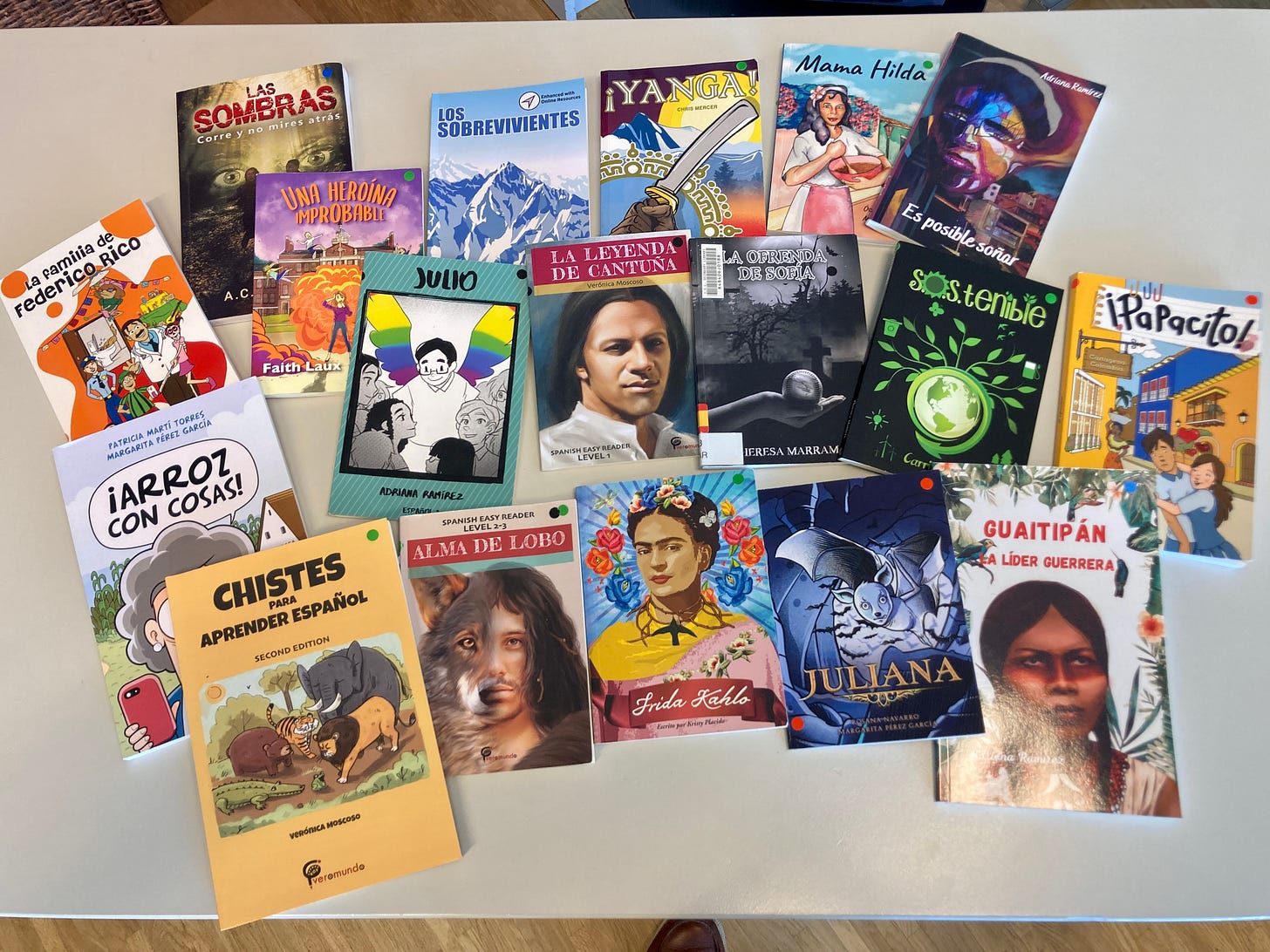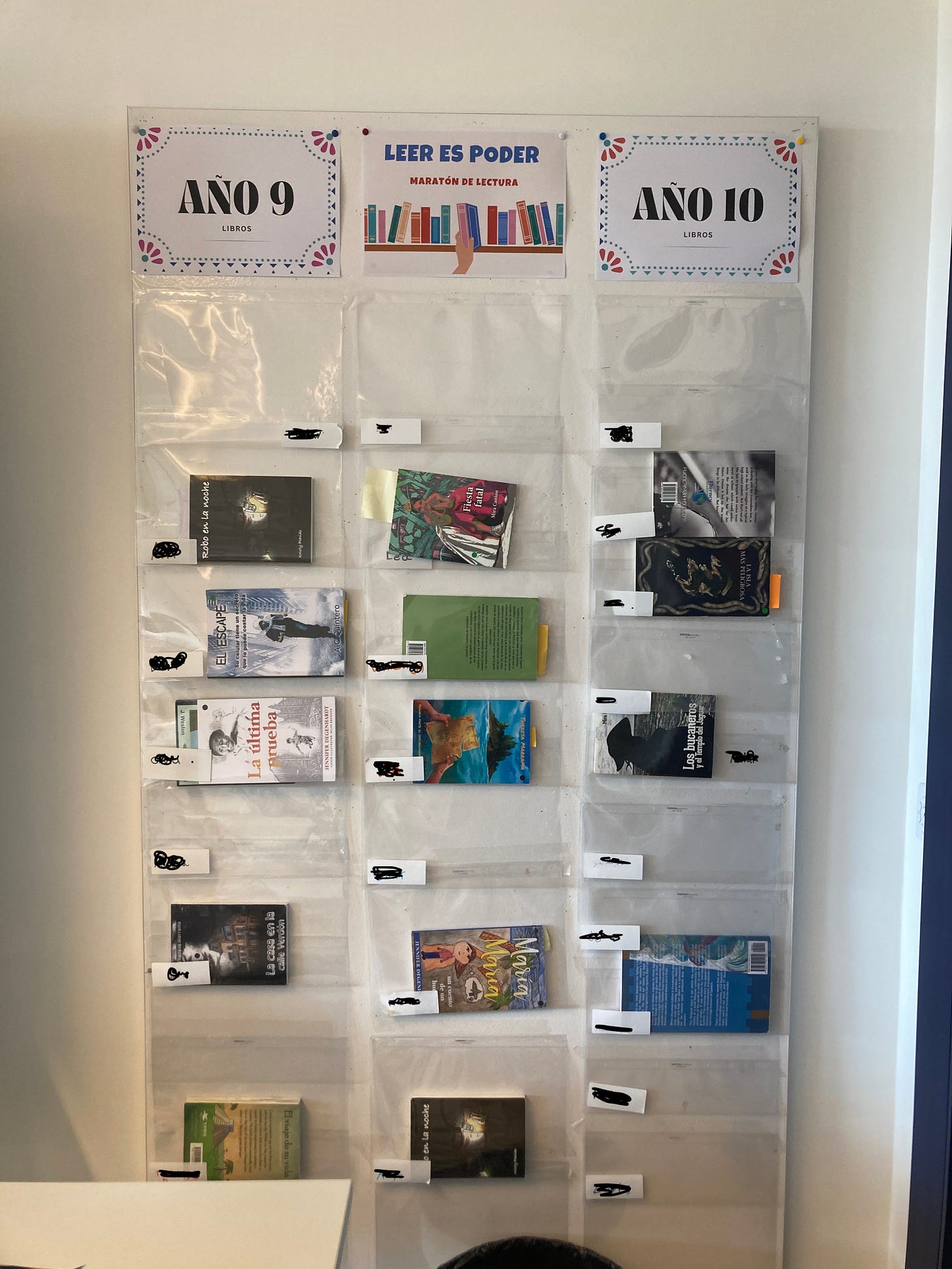Teaching a language through graded novels
How to use a class novel in lessons to increase input and engagement
It may be stating the obvious, but how we structure our languages curriculum is important as it goes to the core of what we do with our students in every lesson. In this blog post I’m going to reflect on how we language teachers structure our curricula and specifically, how we can incorporate graded novels into our thematic units.
Traditionally a languages curriculum will be organised around topics or units as a way of grouping together the vocabulary and grammar structures that are to be learned. In secondary schools, we often use topics that are supposedly of interest to the lives of the young people we work with. Typcial examples are the topics of school, holidays, free time, technology etc.
While these topics may or may not (!) interest out students, I suspect that they’re often chosen as a way to practise a particular grammar structure. So we’ll talk about “What did you do last weekend”, in order to practise the perfect tense or “Talk about your future plans!” in order to practise the future tense. A glance at a typical languages textbook in the UK will make it clear that they’re often grammatically contructed. Communication (if we can call it that…) really only serves to practise certain grammar structures.
Besides this explicit grammar approach, topics often try to “cover” certain words in a way that is quite unnatural. So for example, a unit on food will try to teach lots of food vocabulary, which students are often asked to rote learn. They might even be asked to “write a paragraph on what you like and dislike eating” - a pretty unnatural task that has very little to do with genuine communication in the real word.
Carving up language according to grammar structures and vocabulary units might make sense on paper, but it’s a very unnatural way to learn a language. For me, this is one of the reasons why the language classroom can easily become boring. Our students will be learning about the First World War in History, and in Spanish class they’ll be learning to talk about what they ate last night… Hardly inspiring stuff.
A different way - using graded novels
A few years ago I learned about using graded novels (or “graded readers”) to structure a language course, and attended an excellent session on this by Adriana Ramírez at the Agen Workshop. A graded reader is a short novel that is written especially for second language learners. Usually it will have a restricted vocabulary and lots of repetition of key structures. Graded readers are often written at different levels, and if you’re going to use one in your lessons, you’ll need to choose a novel that is at an appropriate level for your students.
Using graded novels in the classroom is a common technique used by CI teachers and has a number of advantages:
· Stories are powerful and research shows that they help student self-efficacy and cognitive load (Tober et al: 2024)
· A well written graded reader will provide lots of comprehensible input and lots of repetition, both of which are vital to learn a language.
· Novels are adaptable and we can use them for many worthwhile and interesting activities.
· Engaging content in the form of a novel gives the class something to coalesce around – and to actually talk about!
· Increased reading helps develop students’ general literacy skills – this is also an important goal of second language learning.
Over the past week I’ve been observing Dr. Liam Printer’s classes at the International School of Lausanne. Liam generally does one graded reader per thematic unit and structures his units around the novels he wants to read with his students. He’ll generally do four units per year. This week Liam started the novel Los Sobreviventes by Bryan Kandel with his year 10 Spanish class. It’s a great, hard-hitting book about the Flight 571 crash in the Andes and the fight for survival of some of the passengers. It was amazing to see a class of teenagers asking questions and discussing this story – all in Spanish.
As well as a class novel that everyone reads together, Liam’s students all read their own self-selected novels. Students pick up their own book as they enter the classroom and class starts with 5-10 minutes of silent reading.
Before starting the novel
It’s important to think about how we approach a novel before starting to read in class. Launching straight into a novel that is too difficult can be overwhelming for our students, and can be demotivating if students are unable to understand what’s going on. I was impressed at how Liam had considered this. Here’s how he approaches a class novel:
· Build-up: Liam gets his students attention by talking a lot about the novel before the class start to read. This builds anticipation and sparks their interest, so that by the time they start reading, they are eager to do so.
· Setting context: Prior to starting Los Sobreviventes, he talked about Argentina and displayed maps on the board (all in target language). He also played a short documentary about the story he found online, treating this like a MovieTalk. All of this was interactive, with lots and lots of questions to the class (in Spanish).
· Front-loading of vocabulary: Difficult words that students don’t know and that are key to understanding the story are taught in advance. These can be displayed on the board and written down, or learned using actions (TPR).
· Retrieval: At the start of the next lesson, Liam started with retrieval practise based on some key aspects of the story (e.g. True or false? Find the error! etc)
· Homework: Students were assigned a task to research Uruguay and to bring photos to class to discuss.
Reading the novel in class
Liam intended to spend a couple of weeks reading the novel in class. As I observed, I was amazing to see the whole class engaged as they read. The atmosphere was calm and everyone was focused – because there was something worth focusing on. There were no worksheets, no writing exercises for the sake of it: just reading and discussing in Spanish.
I observed a few interesting things in the class:
· Reading: Liam read the bulk of the text as the narrator, but called on students to read at various points. The class were listening and reading a lot as Liam read aloud, but always knew they could be called upon to read (and were therefore fully engaged). Because Liam’s relationship with his students was warm and based on trust, being asked to read was accepted as completely normal.
· Acting out: Liam often asked students to read dialogue in the text, and a few times got them to act out passages from the text, which they very much enjoyed! He was careful to differentiate here and to pick students who would enjoy doing this.
· Breaks: Reading was interspersed with frequent breaks, so the class weren’t reading for long periods of time, and students often worked in pairs. Some examples: “Find the Spanish for X in the first paragraph!”, “Choose a word that is interesting and discuss with your partner!”, “Read the text on the powerpoint and find the errors!”
· Questioning: Although the class were reading lots, the lesson was anything but passive. There was lots and lots of questioning in order to check for understanding and provide even more input based on the novel.
· Homework: The class were asked to read the next chapter as homework and to write a reflection on it in Spanish. Interestingly, Liam prefers to give more input based tasks as homework, rather than output tasks.
Once the class have finished the novel in a few weeks time, they’ll do a summative assessment on the novel. This could be a spoken assessment: “You’re a survivor of the plane crash on a TV show and you’ll talk about your experiences” or a written assessment “Write an email to X person… etc”.
Conclusion
Building class novels into our thematic units offers a lot of potential for increased input and stimulating content that pupils can really buy into. I’m excited about incorporating more graded readers into my own teaching. I did my first graded novel last year with a class in their second year of learning German, and they absoluely loved getting into the story and discussing this in class. There really is no comparison to a textbook lesson, as my students were keen to tell me when we finished reading the novel…
If you’re looking for good graded novels for your classes, check out the the CI Bookshop. They offer a great selection of novels at different levels and for different languages. In my experience, the language used in these novels is very comprehensibile and lends itself well to classes for teenagers.
References
Tober, S et al (2024). Telling stories as preparation for learning: A Bayesian analysis of transfer performance and investigation of learning mechanisms. In Learning and Instruction 92.




Thanks Jonathan! I have really enjoyed reading your blog post as I too am a big fan of Liam Printer and his work. (Feeling a tad jealous you had the opportunity to experience a week in his classroom! How fabulous!) I am a strong advocate of the power of reading and passionate about providing more accessible reading materials for emergent readers of Japanese. I feel sadly that many classrooms are still restrictively tied to units and themes and driven by textbooks, but I have hope for change in the future as the momentum for CI increases. Looking forward to your next post!
Thanks Jonny. I loved reading this summary. Excellent as always and really captures the magic of teaching languages through narrative.